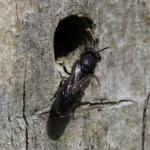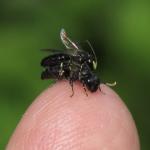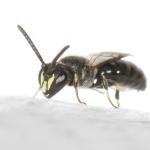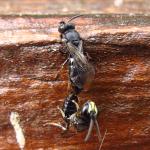Prosopis ciliata Eversmann, 1852, Hylaeus alienatus Förster, 1871, Hylaeus marginatus Förster, 1871, Hylaeus ebeninus Förster, 1871, Hylaeus nigricornis_homonym Förster, 1871, Hylaeus nitidulus_homonym Förster, 1871, Prosopis rupestris Smith, 1872, Prosopis annulata var tristis_homonym Dalla Torre, 1877, Prosopis foersteri Dalla Torre and Friese, 1895, Prosopis annulata var nigrifacies Alfken, 1913, Prosopis communis var rejecta FK Stoeckhert, 1954
The female can be identified by a combination of the finely striated clypeus, the wedge shaped paraocular (facial) markings and absence of white hair fringes on first gastral tergite. The male has, amongst British species, uniquely shaped paraocular markings, their apices being turned inwards around and above the antennal sockets.
Throughout much of Britain, from the south coast north to southern Westmorland and North-east Yorkshire. Sporadic in Wales, known mainly from the south coast, though possibly under-recorded. In Ireland, known from Wicklow, Meath (Ronayne & O’Connor, 2003), Dublin and Kildare. Until very recently there were no records for Scotland, but in 2007 specimens were reared from pieces of dead pine wood collected in the Black Wood of Rannoch, Mid Perth, by M Rejzek (Shaw, 2008). The species is also known from the Channel Islands, having been reported from Guernsey (M Archer, pers. comm.).
The species occurs widely in the western Palaearctic, from much of Europe south to North Africa (Morocco) and east to northern Iran (Koster, 1986).
This species is not regarded as being scarce or threatened.
Generally distributed, having been found in many habitats, including open woodland, grassland and coastal sites. It is often observed in private gardens. Most often encountered at rest on sunlit surfaces (especially dead wood) and visiting umbellifer flowers.
Apparently univoltine; late May or early June to mid September. However, in parts of Germany this species has a second generation (Häseler, 1972) and this may occur in Britain, but may have been overlooked.
An opportunistic cavity-nester, utilising existing burrows of a suitable diameter, particularly in dead wood and woody stems (such as bramble), but also in the soil and crevices in mortar joints.
This bee visits many different plant species for nectar.
The cleptoparasitic aculeate wasp Sapyga quinquepunctata (Fabricius) (Sapygidae; see Edwards & Telfer (2001)) has been reared from the nests of Hylaeus communis (Hallett, 1928). The gasteruptiid wasp Gasteruption jaculator (Linnaeus) and a chalcid wasp in the genus Coelopencyrtus (Encyrtidae) have also been reared from nests of this bee in trapnests (C R Vardy, pers. comm.)
2012








